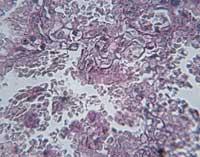Stem blood cells are created in the laboratory
2017/05/17 Etxebeste Aduriz, Egoitz - Elhuyar Zientzia Iturria: Elhuyar aldizkaria

Two papers published in the journal Nature collect two methods for the creation of blood stem cells in the laboratory. Scientists around the world have been trying to achieve this for a long time. It can be an important step in cell therapy, drug testing, research and treatment of leukemia, etc.
All blood cells come from blood stem cells in the bone marrow. These stem blood cells are formed in the development of the embryo from special endothelial cells of the walls of blood vessels, hemogenic endothelial cells. The molecular mechanisms of this conversion are not yet known, but are believed to be the key to obtaining stem blood cells in the laboratory. The two research groups have been based on this.
Ryohichi Sugimura and his companions left pluripotent stem human cells. These cells are able to produce any cell in the body. In this case, a method was first adapted for the creation of hemogenic endothelial cells and subsequently seven transcription factors were identified that lead to the transformation of these cells into blood stem cells. These factors resulted in obtaining young stem blood cells that were introduced into the bone marrow of mice for their maturation.
Raphael Lis and his colleagues have managed to directly convert the endothelial cells of adult mice into blood stem cells, using four transcription factors, two of which are the same as those of the other group. And in this case the cells were placed in a culture of endothelial cells taken from the umbilical cord for maturation.
Blood stem cells developed by both groups were successfully introduced into the mouse, from which the main types of blood cells developed.

Gai honi buruzko eduki gehiago
Elhuyarrek garatutako teknologia






